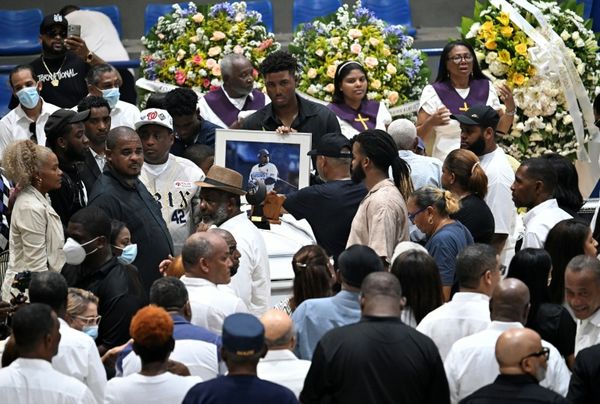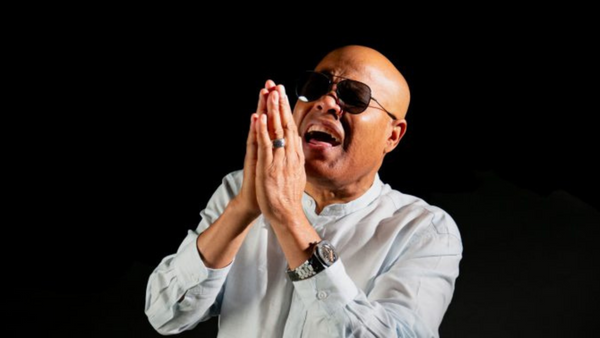You’ve seen the seedings, now let’s get to the real rankings. Here’s how the field stacks up, 1 to 68, based on each team’s ability to win the national championship:
1. Alabama
Seed: No. 1 in the South. The Crimson Tide had a great season but kicked it up another two notches at the Southeastern Conference tournament, romping through three games by an average margin of 17.7 points. While the up-tempo offense and three-point barrages get a lot of attention, Bama’s defense is the biggest separator, especially at the rim. SEC tourney opponents made just 47 of 137 two-point shots, 34.3%. If the Tide can handle both the pressure of expectations and the media spotlight that comes with a murder investigation that involved two current players who have missed no playing time, they will win their first basketball national title in school history.
2. Kansas
Seed: No. 1 in the West. The Jayhawks might top this list if it weren’t for concerns about coach Bill Self’s health. All statements say Self is doing well after having a procedure performed and being hospitalized through the Big 12 tournament, and hopefully that’s the case. But jumping back into the stress and long hours of tournament coaching sounds daunting. If Self is fine, he’ll give Kansas a bench advantage over everyone else in the field. Even if he has to dial it back and defer more to his staff, the Jayhawks have championship DNA and very good players.
3. Duke
Seed: No. 5 in the East. The super-hot team doesn’t always maintain momentum into the Big Dance, but I’m willing to ride with the Blue Devils based on three simple ingredients: They have elite talent, with multiple pros on the roster; they have great size, should it be needed against the likes of Alabama and Purdue and Arizona; they have a veteran point guard and leader in Jeremy Roach. After working through a few injuries, waiting for some freshmen to blossom and melding in transfers, Jon Scheyer has turned the corner with his first team and appears poised for the kind of tournament performance Duke has come to expect over previous decades under Mike Krzyzewski. However, the draw is not easy.
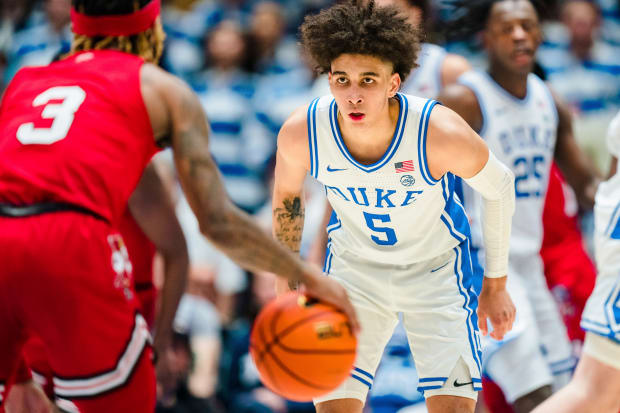
Jacob Kupferman/AP
4. Texas
Seed: No. 2 Midwest. The Longhorns finished second in the nation’s best conference despite their coach being first placed on leave and then fired. Then they won the Big 12 tournament despite an injury to No. 3 scorer and leading rebounder Timmy Allen. So they have some resilience about them. Chances of making the school’s first Final Four in 20 years certainly increase if Allen is available, but even so this is an old, unified team that hasn’t let anything deter its mission. A Final Four back home in Texas is sitting on the horizon, waiting for the Horns to seize it. If they get there, coach Rodney Terry will get this job full time. Even if they come close, he probably should get it.
5. Arizona
Seed: No. 2 in the South. The Wildcats seemingly had all the pieces last year but lacked sufficient tourney seasoning and were ousted by Houston in the Sweet 16. A year older and wiser, and seemingly a bit tougher, they could be poised for a run to the school’s first Final Four since 2001. Arizona has immense size with Ažuolas Tubelis (6'11", 245) and Oumar Ballo (7'0", 260), capable shooters and a savvy mix-master point guard in Kerr Kriisa. Winning a couple of tense slogs against rival UCLA was a good sign of the Wildcats’ willingness to grind out games.
- How to bet on the men’s NCAA tournament
- Printable NCAA brackets: Men’s | Women’s
6. Houston
Seed: No. 1 in the Midwest. The hope is leading scorer Marcus Sasser will be able to go after injuring a groin in the AAC tournament and sitting out a title-game loss to Memphis. With him, fellow guard Jamal Shead and freshman forward Jarace Walker, the Cougars have sufficient offensive firepower to reach the Final Four in their hometown. Without him, every game becomes a defense-and-rebounding trench battle that probably ends somewhere short of the tournament’s last weekend. There is no doubting Houston’s will, but there are concerns about its skill if left short-handed.
7. Purdue
Seed: No. 1 in the East. The Boilermakers’ tournament tales of woe are lengthy, capped last year by a Sweet 16 meltdown against No. 15 seed Saint Peter’s. Against that backdrop, here comes Purdue with its first No. 1 seed since 1996—and a brutal draw. Memphis and Florida Atlantic loom as challenging second-round opponents, and red-hot Duke could be lying in wait in the Sweet 16. On the opposite side of the East Region are four coaches (Tom Izzo, John Calipari, Shaka Smart and Rick Barnes) who have what Matt Painter lacks—Final Four experience. Purdue has a defense-warping force of nature in 7'4" Zach Edey; does it have enough help around him to get to Houston?
8. Gonzaga
Seed: No. 3 in the West. This team is less talented than coach Mark Few’s past two, which went a combined 59–5, but it is still capable of a run. The Zags might be in a more comfortable role without the pressure associated with a No. 1 seed, and Drew Timme’s supporting cast has made strides over the past month. A potential UCLA-Gonzaga matchup could be the best game of the Sweet 16 round. Few has won more NCAA tournament games than any coach over the past five tourneys, so disregard at your own peril.
9. UCLA
Seed: No. 2 in the West. Depending on this week’s injury report, the Bruins could move up several spots. They lost big man Adem Bona and defensive ace guard Jaylen Clark last week—Bona had a shoulder injury and appears more likely to play in the NCAAs; Clark had a reported Achilles injury that could end his season but the school has not confirmed or denied. This much we know: UCLA will defend and compete, possession by possession, to the fullest extent of who it can put on the floor. Make some shots, and the ceiling goes up appreciably.
10. Marquette
Seed: No. 2 in the East. The Golden Eagles have had one of their best seasons, winning the Big East regular-season and tournament titles. They’ve won nine straight and 14 of their past 15, playing a fun offensive style that revolves around point guard Tyler Kolek (13.3 points, 4.2 rebounds, 7.7 assists, 1.8 steals). Now, coach Shaka Smart has to reconnect with his younger, Final Four self of 2011. Smart’s past six NCAA tournament appearances—two at VCU, three at Texas and one at Marquette—have ended in first-round knockouts. Vermont, which has NCAA experience, won’t be an easy out.
11. Indiana
Seed: No. 4 in the Midwest. The Hoosiers have star power in Trayce Jackson-Davis, who does as much for his team as anyone in the tournament (20.8 points, 10.9 rebounds, 4.1 assists, 2.7 blocks per game). They have an NBA-level talent at guard in freshman Jalen Hood-Schifino, whose 35-point performance at Purdue revealed his potential. They have role players who can shoot and defend multiple positions. Is that enough to make a Final Four? Maybe. Their path winds through an unpleasant chapter in Indiana history, with an opening game against Kent State and coach Rob Senderoff, and potentially a Sweet 16 game against Houston and Kelvin Sampson—both Senderoff and Sampson were sanctioned by the NCAA for violations committed with coaching at Indiana.
- Round-by-round bracket predictions: Pat Forde | Kevin Sweeney
12. Baylor
Seed: No. 3 in the South. There have been times these Bears have flashed the talent of the 2021 team that stormed to the national championship. But those times have been temporary, counterbalanced by 10 losses against teams in this tournament (three to Iowa State alone). Let’s assume the record is a byproduct of playing in the brutally tough Big 12, and expect Baylor to make another significant advancement in the bracket. Coach Scott Drew’s team lives at the three-point line, taking 45% of their shots from there, and it has shooters capable of huge games. The struggle comes inside, where Baylor is vulnerable on the glass and in defending the paint. In the Big 12 tourney loss against the Cyclones, big men Jonathan Tchamwa Tchatchoua and Flo Thamba combined for zero rebounds in 37 minutes.
13. Connecticut
Seed: No. 4 in the West. Hard to believe, but UConn hasn’t won an NCAA tournament game since 2016 and hasn’t advanced to the second weekend since winning it all in ’14. This team has a chance to turn back the clock at least part way to the Huskies’ gilded past. They lead the nation in offensive rebounding, per Ken Pomeroy, and pass the ball well in search of good shots. Adama Sanogo (16.8 points, 7.3 rebounds) is one of the underrated players in the tourney. UConn started the season 14–0, with a lot of big wins, including one against Alabama, and then flattened out in January. After that, a recovery that hints at a potential run.
14. Texas A&M
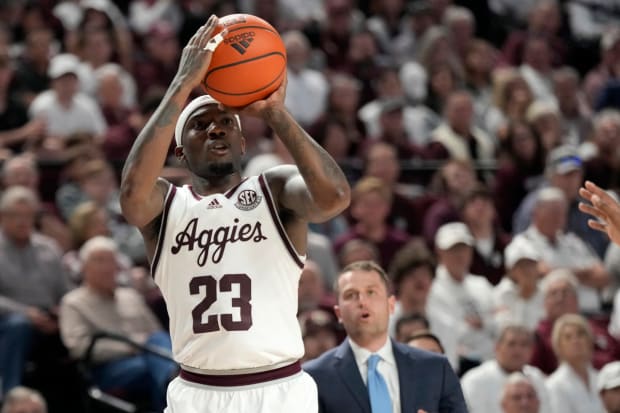
Sam Craft/AP
Seed: No. 7 in the Midwest. This was the worst seeding job done by the committee, giving a team that finished second in the SEC and made the tournament final a No. 7 seed. (Early losses against Murray State and Wofford hurt.) The Aggies are better than that—tough and active defensively, aggressive on the offensive glass and effective at getting to the foul line. Wade Taylor and Tyrece Radford combine for 29.9 points per game in one of the better backcourts in the tournament, and Buzz Williams is an underrated coach. A potential game against Texas could be the juiciest of the round of 32.
15. Xavier
Seed: No. 3 in the Midwest. Sean Miller’s first season back at the school he took to four straight NCAA berths from 2006 to ’09 has been a huge success after the Musketeers missed the last three Big Dances. He’s got a balanced team that has withstood the loss of forward and leading rebounder Zach Freemantle, relying on ball movement and shot selection to become one of the most efficient offensive teams in the country. Colby Jones has stepped up his game in March, alongside guard Souley Boum and 7-footer Jack Nunge. Xavier isn’t very disruptive defensively and doesn’t have much depth.
16. TCU
Seed: No. 6 in the West. If the Horned Frogs can make threes for a few games, they’re another Final Four contender from the state of Texas. One of the nation’s least accurate teams outside the arc (30.6%) has recently shown some improved proficiency in that area, making 19 of 44 threes in the Big 12 tourney, so there might be hope. (Star guard Mike Miles Jr. is 9-of-18 from three the past three games.) Like most Jamie Dixon–coached teams, the Frogs hang their hat on disruptive defense. They’re borderline frantic at times offensively.
17. Memphis
Seed: No. 8 in the East. This could go either way—the Tigers continue their AAC tournament stampede and upset Purdue in the second round, or they leave their A game in Fort Worth and get taken out by Florida Atlantic in the first round. All things are possible. They do have the Stetson Bennett of college basketball—but older. He’s 26-year-old forward DeAndre Williams, a bouncy forward who averages 17.8 points and eight rebounds per game. His 23-year-old running mate is guard Kendric Davis, an SMU transfer capable of going for 30 at any time.
18. Florida Atlantic
Seed: No. 9 in the East. The underrated Owls (31–3) were jobbed in terms of their seeding and first-round opponent (Memphis), inhibiting chances for a run to the second weekend. It would be fun to see them match up with Purdue in the second round, because they have a 7'1" center (Vladislav Goldin) who could at least come close to looking Zach Edey in the eye. Guard tandem Johnell Davis and Alijah Martin are 13-point, five-rebound guys, leading a team that can go nine deep. Coach Dusty May should be in line for any number of jobs if he wants them.
19. Kansas State
Seed: No. 3 in the East. The Wildcats have been one of the best success stories of the season under first-year coach Jerome Tang and behind Florida transfer Keyontae Johnson, who survived a near-death collapse at Florida State in December 2020 and did not play for nearly two years. The 6'6" Johnson and 5'8" guard Markquis Nowell are the do-everything players for K-State, combining for 34.5 points, 10.5 rebounds, 9.8 assists … and 6.7 turnovers per game. This is a transfer-heavy team that has scant NCAA tourney experience and is playing for a rookie head coach, which creates an air of mystery and anxiety. Tang, a longtime Scott Drew assistant at Baylor, has some accomplished March masters potentially in his path in John Calipari and Tom Izzo.
20. Creighton
Seed: No. 6 in the South. The Bluejays have been a perplexing tease much of the season. They looked great in Maui in November, then dropped five straight and seven of the next 10 (coach Greg McDermott might have overscheduled). That was followed by a strong push from mid-January through mid-February before faltering again. Creighton’s last win against an NCAA tournament team was Feb. 11, and it hasn’t beaten one away from home since before Thanksgiving. The Bluejays have a talented starting five but not much depth. A second-round game against Baylor would be a good one, but they’ll have to beat N.C. State first.
21. Drake
Seed: No. 12 in the Midwest. Love the Drake. Don’t love the Drake’s draw, getting Miami in the first round and potentially Indiana in the second. But the Bulldogs are too good and too experienced to be in this thing for only 40 minutes. Coach’s son Tucker DeVries (19 points, 5.6 rebounds) and point guard Roman Penn (12.6 points, 4.6 rebounds, 5.4 assists) form a nice lead tandem, but there is more to Drake than that. The Bulldogs have a major paint presence in 6'10", 275-pound Darnell Brodie, one of the reasons they don’t give up a lot of second-chance points. Drake was dominant in the Missouri Valley tournament, and if it didn’t lose that edge in the 12 days between wrapping the autobid and playing Miami, that’s a strong 12–5 upset opportunity.
22. Miami
Seed: No. 5 in the Midwest. The Hurricanes’ tourney viability depends heavily on the health of their lone productive post player, Norchad Omier, who injured an ankle early in an ACC semifinal against Duke and didn’t return. With him, Miami has a well-rounded offense with Omier inside and the perimeter firepower in ACC Player of the Year Isaiah Wong, Jordan Miller and Nijel Pack. He’s also vitally important for a mediocre defensive team. Miami’s penchant for playing fast and loose suits its strengths but can lead to some questionable time-and-score decision-making that makes close games an adventure.
23. Virginia
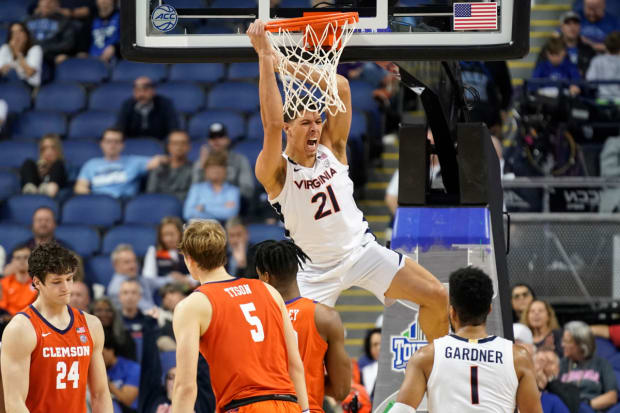
Chuck Burton/AP
Seed: No. 4 in the South. The bracket presents a Sweet 16 opportunity for the Cavaliers, but it remains to be seen whether they’re good enough to capitalize. They compensated for the season-ending injury to forward Ben Vander Plas relatively well in the ACC tourney and will continue to need a combination of 7-foot freshman Francisco Caffaro and 6'11" Kadin Shedrick to fill those minutes. Ultimately, this is a moderately talented team that has to do everything by committee, and there is a question about whether the committee can score enough points—a common Tony Bennett challenge. Virginia hasn’t won an NCAA tournament game since cutting down the Final Four nets in 2019.
24. Saint Mary’s
Seed: No. 5 in the West. The Gaels are trying to break the first-weekend barrier for the first time since 2010. They have what Ken Pomeroy rates as their best team ever, No. 11 nationally at this point, reliant on vigilant defense and methodical offense to frustrate opponents. No wonder ESPN analyst Jay Bilas calls them “West Coast Virginia.” That should result in an extreme tempo battle against first-round opponent VCU, which thrives on forcing turnovers and running off of them. Coach Randy Bennett has a rising college star in freshman guard Aidan Mahaney to pair in the backcourt with Logan Johnson, a veteran of 141 college games. Postman Mitchell Saxen is charged with clogging the middle defensively and mucking up ball screens.
25. Michigan State
Seed: No. 7 in the East. There is an opportunity here, and it wouldn’t be the first time Tom Izzo got a puzzling, inconsistent team on a tourney heater and made a deep run. But the Spartans have to relocate their customary defensive tenacity to get anywhere. That’s been an issue in recent weeks, particularly in defending off the dribble and the corresponding pitches out to the three-point line. Michigan State has five offensive players capable of being its leading scorer on a given night, but some consistency on that end would help. Who steps up, and for how long, could decide whether the Spartans make the Sweet 16 for the first time since reaching the Final Four in 2019, or get bounced in the first round by USC.
26. Missouri
Seed: No. 7 in the South. This has been a season of joy and enthusiasm for the Tigers, who were picked to finish 11th in the SEC and wound up fourth. Senior forward Kobe Brown leads an improbable cast of transfers from mid-major schools. Their 24 wins in Year 1 under coach Dennis Gates doubles last year’s total, and Mizzou’s fast-paced, fearless playing style has been welcomed by a fan base that had become a bit apathetic. Will it translate to the tournament, where Missouri hasn’t won a game since 2010? That will largely depend on the Tigers’ ability to guard and grab defensive rebounds, two weak areas all season. Their game against Utah State could be the highest-scoring first-round game of the tourney.
27. West Virginia
Seed: No. 9 in the South. The Mountaineers played their way into the bracket in the closing weeks of the season, winning four of their last six with the losses both to Kansas. They play with the customary Bob Huggins zeal for contact—fouling a lot and drawing a lot of fouls. Their 23.2 free throw attempts per game rank 12th nationally and third among tournament teams. This isn’t a great defensive team by Huggins standards, but they do create turnovers and manufacture a fair number of points that way or via the offensive glass. Guard Erik Stevenson, playing for his fourth school, leads a balanced offense.
28. Arkansas
Seed: No. 8 in the West. The Razorbacks might be the biggest tease in the tournament. Do they have talent? Length? Athleticism? Goodness, yes. Are they poor shooters with shaky selection, sometimes lacking composure and occasionally selfish with the ball? Yes to all that as well. In other words, it would be no surprise to see the Hogs in Houston or bum-rushed in the first round. All things are possible. Coach Eric Musselman has made successive regional finals, but this team—with multiple first-round draft picks—is trying to turn around an underachieving season.
29. Northwestern
Seed: No. 7 in the West. The raucous Selection Sunday celebration in Evanston when the Wildcats were shown in the bracket underscores the rarity of this achievement—just the second men’s NCAA bid in school history. Staying the course with coach Chris Collins proved to be a good decision despite five straight losing seasons since that initial bid, as he has overcome a rash of transfers by building this team around two holdover guards, Boo Buie and Chase Audige. Northwestern is very much a methodical, defense-first operation, content to grind out possessions and make plays late in the shot clock. Unfortunately for them, that fits the comfort zone of first-round opponent Boise State and potential second-round opponent UCLA.
30. Charleston
Seed: No. 12 in the South. No one does things quite like coach Pat Kelsey, both in terms of roster building and playing style. This collection comes from all levels of college basketball and all over the globe: 24-year-old leading scorer Dalton Bolon is in his seventh college season; post presence Ante Brzovic is from Croatia via Southeastern Oklahoma State; top three-point shooter Reyne Smith hails from Australia; and so on. Kelsey has nine players averaging at least 15 minutes a game, which helps maintain a frantic pace of play. With 31 wins, Charleston barely remembers what it feels like to lose and could be a bracket breaker.
31. San Diego State
Seed: No. 5 in the South. Let’s pause to appreciate the incredible consistency of the Aztecs, who have now authored 18 straight winning seasons—17 of those with 20 or more wins, three with 30 or more. It would be easier to recognize SDSU’s accomplishments if the COVID-19 pandemic hadn’t wiped out a 30–2 season and if the program did a little more in this tournament. Their last tournament win was in 2015. This team is much like its predecessors: excellent defensively, especially at the three-point line; balanced offensively; good in close games (9–2 in outcomes of six points or fewer). But the committee did the Aztecs no favors with the Charleston draw, presenting the possibility of another first-round knockout. Get by the Cougars, however, and a Sweet 16 seems possible.
32. Kentucky
Seed: No. 6 in the East. The Wildcats arrive with angst percolating around the program after a disappointing season and another early exit from the SEC tournament. But even Calipari has to cease his habitual complaining about his team’s draw this year—the Cats are positioned for a potential run, if they’re up to it. Aside from having to face Wildcats benchwarmer turned star Bryce Hopkins, Providence is a welcome opening opponent. A potential second-round game against Kansas State highlights Kentucky’s size advantage; after that, you take your chances. But the overarching question is whether this team is capable of any consistency, especially defensively, in a season filled with lapses.
33. Penn State
Seed: No. 10 in the Midwest. Coach Micah Shrewsberry and star player Jalen Pickett have done fine work dragging this team off the bubble, into the tournament and out of Dayton. Now we’ll see if they can maintain the momentum after a draining Big Ten tournament. (The only thing we can count on is a close opening game against Texas A&M; the Nittany Lions’ past eight games all have been decided by four points or fewer.) Stylistically, Penn State looks like a Jay Wright Villanova team: Pickett is a 6'4" post-up player in a spread offense, facilitating three-point shooters or scoring in the paint. Size and athletic limitations leave the Nittany Lions susceptible defensively, but they control tempo and try to pull out wins late. Problem: Under-seeded Texas A&M will be fine playing that way, too.
34. Utah State
Seed: No. 10 in the South. Look who’s back: Ryan Odom, architect of the biggest upset in NCAA tournament history while the coach at UMBC in 2018. Now in his second season with the Aggies, he’s got a fun offensive team that has won seven of its last eight, losing only in the Mountain West championship game. There is just one player in the tournament who has made more three-pointers this season than guard Steven Ashworth, who has canned an even 100. Utah State isn’t great defensively and likes to push the tempo, so the opener against Missouri should be a track meet. After nine first-round losses, can the Aggies earn their first NCAA win since 2001?
35. Iowa State
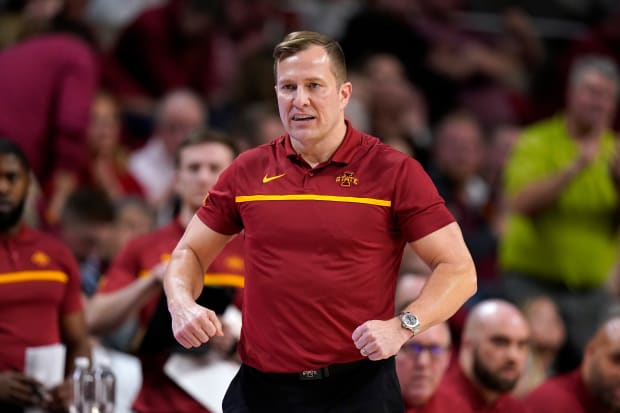
Charlie Neibergall/AP
Seed: No. 6 in the Midwest. Can T.J. Otzelberger and his biceps-enhancing smedium polo shirts rekindle last season’s finish? The Cyclones lost their past three games before the Big Dance, then won a couple of close ones to crash the Sweet 16. This year’s team has lost five of its last seven, and Otzelberger is reconfiguring roles after the late-season dismissal of guard Caleb Grill. But Iowa State will defend until the last second, forcing turnovers with aggressive physicality. A potential Mississippi State–Iowa State game could be the biggest rock fight of the first round.
36. Kent State
Seed: No. 13 in the Midwest. Be sure to check out Golden Flashes guard Sincere Carry. He’s the kind of player upon whom Cinderellas are built, a brassy floor leader and shot maker averaging 17.6 points and 4.9 assists while rarely leaving the floor. (His average minutes over the past seven games: 39.3.) Kent State is a dangerous team stuck with a difficult draw with Indiana, because the Golden Flashes will struggle with the Hoosiers on the glass and coach Rob Senderoff will have to answer a lot of questions about committing NCAA violations as an IU assistant in the 2000s. Kent State can try to avenge a 2002 regional final blowout loss to Indiana, which the Flashes had as a No. 10 seed.
37. Iowa
Seed No. 8 in the Midwest. The Hawkeyes are always good enough offensively to make the NCAA tournament and never good enough defensively to make the Sweet 16. This team is straight out of that Fran McCaffery cookie cutter: skilled and fast and fastidious with the ball; likely unable to get enough stops to make a deep run. The committee gave Iowa a beatable opening opponent in Auburn but did the Hawkeyes no favors by putting the game in Birmingham. Should Iowa win that game, a matchup of its offense against Houston’s defense would be a great, strength-on-strength battle in the second round. Just don’t expect the Hawkeyes to win it (unless Marcus Sasser is still injured, then maybe).
38. Oral Roberts
Seed: No. 12 in the East. A Cinderella dream meets an awful draw, with the Golden Eagles getting Duke in the first round. The Blue Devils are no five-seed, and their two-big lineup presents matchup issues for a team with one giant (7'5" Connor Vanover) and a bunch of guards. But diminutive scoring dynamo Max Abmas and coach Paul Mills have shocked the tourney before, reaching the Sweet 16 in 2021 as a No. 15 seed. And this team has had a better season than that one, winning 30 games and storming through the Summit League 21–0, including the league tourney. Beware of teams that don’t even remember what it’s like to lose.
39. Maryland
Seed: No. 8 in the South. The Terrapins haven’t played terribly well over their past seven games, going 3–4 with two wins against Minnesota and losses to Nebraska and Ohio State. Guard Jahmir Young, team leader in points (16.1), assists (3.2) and steals (1.3), had a rough Big Ten tourney, going 6-for-28 from the field—something that will have to change for Maryland to advance. First-year coach Kevin Willard knows his way into the tournament after five bids with Seton Hall, but he’s just 1–5 in the Big Dance. If the Terps continue handling the ball well and withstand West Virginia’s pressure, they could get a shot at Alabama.
40. VCU
Seed: No. 12 in the West. It feels like the tourney gods own the Rams one, after they were eliminated by COVID-19 testing before even playing a game in the 2021 bubble tourney in Indianapolis and not making the field last year. The draw gives them a chance, in what will be a sharp, stylistic clash with deliberate Saint Mary’s. VCU is slightly less of a rip-and-run team than in years past but still makes its living with disruptive defense and transition offense. This is a scoring-by-committee team, with Michigan transfer Brandon Johns Jr. blossoming into a key contributor after mostly riding the bench in Ann Arbor.
41. USC
Seed: No. 10 in the East. The Trojans have been the definition of an unremarkable at-large team—doing pretty much what was expected of them all season, no more and no less. Beating UCLA at home in late January and Arizona State twice got them in the field, though not by a lot, and their first-round reward is Tom Izzo and Michigan State. Guard Boogie Ellis can get hot and get to the foul line, but USC needs the versatile Drew Peterson to get back on his game. The 6'9" Peterson, who is second on the team in scoring and leads in rebounds and assists, has made just seven of 31 shots thus far in March. USC is good enough defensively to give Michigan State problems and could do the same to Marquette if it can advance.
42. Providence
Seed: No. 11 in the East. The Friars’ season has careened off the rails, with three straight losses and four in the past five games. A mystifying home blowout loss against Seton Hall was attributed by some to the players’ attending a Lil Durk concert the previous night, but perhaps coach Ed Cooley’s name being linked to the Georgetown job has weighed more heavily than Lil Durk. Whatever the reason, Providence is a team going the wrong way at the wrong time and paired with the wrong opponent in Kentucky—the Friars might not be equipped to handle Oscar Tshiebwe in the post. Maybe Kentucky transfer Bryce Hopkins can put the team on his back, but his struggles the past five games mirror the team’s.
43. Auburn
Seed: No. 9 in the Midwest. The Tigers exude an aura of dysfunction, having lost seven of their past 10 games. Their last win away from home was Jan. 21. Their last win away from home against an NCAA tournament team was Nov. 23, in Mexico. In going 4–9 over their past 14 games, Auburn has played a lot of close games but won almost none of them (1–6 in outcomes of five points or fewer). Coach Bruce Pearl hitched his wagon to ball-dominating point guard Wendell Green Jr., and the results are the results. During the past 13 games, Green has taken 152 shots and made 52 (34.2 percent), while big man Johni Broome has taken 150 and made 82 (54.7 percent). Green’s points per attempt: 0.8. Broome’s points per attempt: 1.1. Auburn was given a sweetheart regional draw that places the Tigers in Birmingham. Given how much better they’ve played at home, maybe that will be a tangible advantage against Iowa—and, potentially, in the second round against Houston.
44. Illinois
Seed: No. 9 in the West. The Illini are another team going the wrong way at the wrong time, having lost six of their past 10 and last winning away from home in January. They attempt a lot of threes (42% of their shots), but don’t make enough to justify the volume (30.9%, 331st nationally). They also don’t shoot well from the foul line (68%), another danger sign for tournament time. But Illinois is not without talent and athleticism, which should make the matchup against similarly unpredictable Arkansas an entertaining one. Coach Brad Underwood hasn’t had much Big Dance success at Illinois, being thumped in the second round the past two seasons with a higher-seeded team.
45. Pittsburgh
Seed: No. 11 in the Midwest. The Panthers seemed to be a safe bet to make the field, but the steady devaluing of their season sweep of North Carolina hurt the résumé before they lost three of their past four games. They’re the lowest-rated Ken Pomeroy at-large team at No. 77. Nevertheless, Pitt gets its shot in Dayton, its first NCAA bid since 2016. Coach Jeff Capel has some good pieces: quality guards, three-point shooters and some capable length. Whether they can defend well enough to advance to the main bracket is the overriding question, and the answer could be an opponent (Mississippi State) that struggles to even make open shots. The bracket presents an opportunity for a run.
46. Arizona State
Seed: No. 11 in the West. Call this the bid that Desmond Cambridge Jr. delivered. First and foremost, the fifth-year guard hit a 55-footer at the buzzer to beat Arizona in Tucson — the biggest win on the ASU résumé. Then he delivered a season-high 27-point performance against USC in the Pac-12 tournament to secure the spot in the field by the thinnest of margins. The Sun Devils probably defend well enough to get out of Dayton and into the main bracket, but probably shoot poorly enough to be eliminated by TCU upon arrival. The Steve Alford–Bobby Hurley coaching matchup in the First Four has to be one of the better showdowns of former great college players in tournament history. They can compare national championship rings.
47. Louisiana
Seed: No. 13 in the East. The Ragin’ Cajuns are built around a rare Sun Belt Conference asset: a big-time center. Jordan Brown, a McDonald’s All-American who has bounced from Nevada to Arizona to Louisiana, averages 19.4 points and 8.7 rebounds. He will test Tennessee’s array of interior bruisers. Coach Bob Marlin’s team is a transfer-portal creation, and it has come together well this season. The Cajuns might have caught a bracket break as well, drawing a Tennessee team that is struggling into the postseason.
48. Tennessee
Seed: No. 4 in the East. Add the Volunteers to the list of power-conference programs that need to find solutions after a stagger down the stretch. They’ve lost seven of their last 12 and they haven’t beaten a tourney team away from home since Jan. 17. The season-ending injury to Zakai Zeigler is brutal at both ends of the floor, since he was the table setter offensively and the catalyst of a vicious defense. The Volunteers can still guard, just not quite as well, while an already shaky offense has struggled with turnovers. Other than rebounding their own misses, the Vols don’t have a lot going for themselves at that end of the floor. Beware of the first-round knockout here.
49. NC State
Seed: No. 11 in the South. First-round opponent Creighton’s scouting job is simple: check the tape for what Clemson has done to the Wolfpack this season. The Tigers beat NC State three times by an average margin of 21.7 points, exposing State’s haphazard defense and propensity to foul. Offensively, Kevin Keatts’s team can be a fun watch: guards Jarkel Joiner and Terquavion Smith can catch fire, and 275-pound center DJ Burns Jr. has surprising skill for his heft. (He is the roundest mound of rebound in this tournament.) It might end quickly, but the Wolfpack’s return to the tournament for the first time since 2018 is a significant step.
50. Iona
Seed: No. 13 in the West. Rick Pitino is going, going … but not yet gone to St. John’s. He will coach the Gaels for one more weekend, a second NCAA tournament berth in three seasons well off the beaten path, the school having given him a chance to rehab his image and remind everyone that he’s one of the greatest coaches in the history of the sport. This Iona team is like a few units Pitino has had in the past, coalescing in the latter half of the season and now carrying a 14-game winning streak into Albany to take on Connecticut. The domination of the MAAC tournament was also vintage Pitino; Danny Hurley won’t need anyone to tell him he’s going up against one of the postseason masters. That said, handling UConn’s offensive talent could be beyond the grasp of the Gaels.
51. Boise State
Seed: No. 10 in the West. The Broncos have been extremely consistent under coach Leon Rice: winning 20 games most seasons, sweating out life on the NCAA bubble, losing their first game in the years when they get in. Maybe this time the last element will change. Boise State is the more experienced NCAA team in its matchup against Northwestern, having been there for a first-round punch-out at the hands of Memphis. This team is defense-first, but shoots it pretty well from distance. Tyson Degenhart could pose a matchup problem for Northwestern in what should be a low-scoring game that suits both teams.
52. Mississippi State
Seed: No. 11 in the Midwest. If the Bulldogs can figure out how to shoot between now and Dayton, they could have something going. As it is, coach Chris Jans has done great work in his first season getting his team into the tournament for the first time since 2019. It will battle on the defensive end for every possession, creating turnovers and contesting shots. On offense, big man Tolu Smith is a fighter inside who absorbs contact and plays through it (he’s shot 43 free throws in the past three games). Win or lose Tuesday, Pitt will walk away knowing it had been in an alley fight.
53. Nevada
Seed: No. 11 in the West. The last team in arrives with a three-game losing streak, all against non-tournament teams. That’s not exactly a ringing endorsement, but here they are. Regular-season wins against fellow Mountain West teams that made that bracket—San Diego State, Boise State and Utah State—got the Wolf Pack in by the scantest of margins. Nevada has some dudes, though, starting with guard Jarod Lucas, who was part of Oregon State’s miracle regional final run of 2021. He has scored 75 points in the past three games. Wing Kenan Blackshear is the other go-to scorer. Steve Alford needs to get Will Baker going again after the 7-foot center has struggled over the past few games.
54. Colgate
Seed: No. 15 in the Midwest. Coach Matt Langel has built a Patriot League juggernaut, earning a fourth straight bid. And one of these days, despite the annual low seed, the Raiders are going to knock off a first-round opponent. Texas is probably too athletic and focused to be susceptible this season, but the Longhorns should understand Colgate will not blink. The Raiders have won 20 of their past 21 games, lead the nation in three-point accuracy (40.9 percent) and thrive off ball movement for good shots. This is a last roundup for a core group of seniors, and they will not go down easily.
55. Furman
Seed: No. 13 in the South. This was a feel-good, breakthrough bid for the Paladins and coach Bob Richey, who have been really strong in recent years without winning their one-bid league. Last year was the crusher, losing the tourney final on a 30-foot shot at the buzzer. This year, Furman got it done and now brings a very solid team to the Dance. The Paladins lead the nation in two-point field-goal percentage at 59.1, largely by spreading the floor and shooting a lot of threes from all five positions. Their offense will provide a good test for Virginia’s defense, while both teams are lackluster at the other end of the floor. Don’t sleep on the ‘Dins, as their jerseys say.
56. Vermont
Seed: No. 15 in the East. The Catamounts are here again, doing what they do, dominating a low-major conference with a blend of fundamental basketball truisms: take good shots, block out and don’t foul. This is their fourth bid in the past six tourneys under consistent coach John Becker, who has benefited from the seamless fit of Bellarmine transfer Dylan Penn (a team-leading 13.5 points per game). In recent years, the Catamounts have made Arkansas, Florida State and Purdue sweat in first-round games, but the goal is to move past make-them-sweat and into the second round. Marquette is on notice.
57. Princeton
Seed: No. 15 in the South. The Tigers’ progress this season can be measured by games against Yale: from a 22-point loss in January to a 10-point overtime loss in February to a nine-point tourney win Sunday for the NCAA bid. Tosan Evbuomwan is an effective scorer inside the arc in a balanced offense. The Tigers are good defensive rebounders, and that will be at a premium against Arizona. Princeton isn’t quite Pete Carril–era slow offensively, but it prefers to be deliberate and might be able to frustrate an Arizona team that always wants to go fast. This is the first tournament without program patriarch Carril, who died in August; maybe they can win one for Pete.
58. UC Santa Barbara
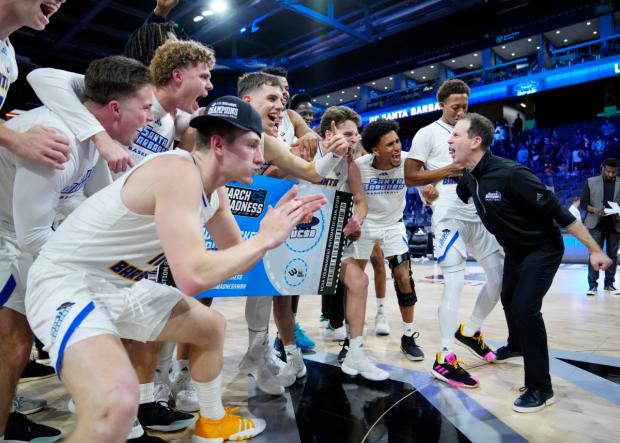
Eric Jamison/AP
Seed: No. 14 in the South. This marked the sixth winning record in six seasons on the job for Joe Pasternack and the second NCAA bid in the past three tourneys. The Gauchos scared Creighton in 2021, taking a six-point lead into the final five minutes before losing by one. The analytics say this UCSB team isn’t as good, but the Gauchos recovered from a three-game February slump by winning their last seven. UCSB has good length and a strong scoring tandem in guard Ajay Mitchell (16.1 points) and forward Miles Norris (14.1). But defending Baylor’s guards could be problematic.
59. Montana State
Seed: No. 14 in the East. We don’t have Wayne Tinkle coaching in this year’s tournament, but for the second straight year we have Danny Sprinkle. His Bobcats are tenacious defenders who don’t let their poor perimeter shooting discourage them. They can move the ball quickly on offense and love to drive it inside, living at the foul line. Montana State won an all-time rock fight of a Big Sky semifinal against Weber State, 60–58 in double overtime, then rolled through the title game to earn a repeat NCAA engagement. Hopefully this game against Kansas State goes better than last year’s matchup against a Big 12 team, a 35-point loss to Texas Tech.
60. Grand Canyon
Seed: No. 14 in the West. The Hurleys aren’t the only brother act in the Dance—Bryce Drew again joins Scott Drew after leading the Antelopes into the field for the second time in three seasons. (It’s Bryce’s fifth NCAA appearance at three schools, not counting his fairly famous appearance in 1998 as a player.) Grand Canyon has won a season-high six straight games, four of them by five points or fewer. Now comes the reality check against Gonzaga. The ’Lopes aren’t very good on the defensive glass and foul a fair amount, both of which are problems against a team that can exploit those flaws.
61. Kennesaw State
Seed: No. 14 in the Midwest. It’s a big March for Owls, with Florida Atlantic earning its first bid in 20 years and Kennesaw State locking down its first bid ever. The methodical building job by coach Amir Abdur-Rahim has been impressive at what was a dead-end program: from 1–28 to 5–19 to 13–18 to now, 26–8 and champions of the Atlantic Sun. And this wasn’t done via the transfer portal; it was a triumph of recruiting and development. Kennesaw has won 16 of its past 18 to get here, shooting accurately from the outside but primarily trying to win with defense and rebounding. If they succeed in getting Xavier into a close game, the Owls will need to shoot better than their 66% season average from the foul line.
62. North Carolina–Asheville
Seed: No. 15 in the West. The Bulldogs are another team that dominated their single-bid conference and barely remember what it feels like to lose. They’re 21–1 in 2023 but showed their mettle by pulling out a couple of close games in the Big South tourney. They have a bell-cow post player in Drew Pember (21.2 points, 9.3 rebounds) and one of the most accurate three-point shooters in the tournament in Tajion Jones (45.6 percent on the season). Ashville turns over the ball rather frequently, which could be a problem against UCLA, and a mid-major team that lives at the foul line might not be able to have its way inside against a high-major power.
63. Northern Kentucky
Seed: No. 16 in the Midwest. Darrin Horn has recruited, and retained, three in-state guards who have keyed this team’s success. Star Marques Warrick (Lexington) and sidekicks Sam Vinson (Fort Thomas) and Trevon Faulkner (Harrodsburg) combine for 39.4 points per game. The Norse are one of the more disruptive teams in the tournament defensively, forcing turnovers at a high rate. That helps compensate for a lack of size and a weakness on the defensive backboard, which will be a red-alert area of concern against the glass-eaters of Houston.
64. Howard
Seed: No. 16 in the West. An excellent season was on the brink with fewer than 20 seconds to play and the Bison trailing Norfolk State by four in the MEAC championship game. That’s when some Howard heroes stepped forward. Marcus Dockery made a three after missing his first five of the game. And after a Norfolk turnover, Jelani Williams made two free throws with six seconds left to secure the victory. Now all the Bison have to do is take on defending national champion Kansas in their first NCAA tournament game in 31 years. Go big or (more likely) go home.
65. Texas A&M–Corpus Christi
Seed: No. 16 in the South. After 25 years as an assistant coach in a variety of locales, Steve Lutz got a shot at Corpus Christi. It’s worked out rather well. He has produced two NCAA bids in his two years leading the Islanders—and this year’s team didn’t just fall off the turnip truck. Corpus Christi has won 12 of its past 13, shoots 37% from three-point range and 80% at the foul line, and plays at a sharp pace. Its defense largely consists of trying to create turnovers, because it’s the third-smallest lineup in the country, according to Ken Pomeroy, and cannot rebound or defend the post. Look for the Islanders to advance out of Dayton to play Alabama in Birmingham.
66. Southeast Missouri State
Seed: No. 16 in the South. The Redhawks went to Evansville for the OVC tourney with a losing record and left with four wins in four days and an NCAA bid. The capper was a wildly dramatic overtime victory against Tennessee Tech that featured the following in the final 15 seconds of regulation: a Tech three-pointer for the lead; Tech fouling SEMO’s Chris Harris on a three and him making all the free throws for the lead; Tech executing a Hail Mary play for the win; a replay review correctly downgrading Tech’s basket from a three to a two and forcing overtime, when SEMO pulled away and won by seven for its first bid in 23 years. Whatever happens in Dayton will be anticlimactic after that.
67. Texas Southern
Seed: No. 16 in the East. Hey, the Houston Cougars aren’t the only tournament team trying to make the Final Four in their hometown. Texas Southern’s campus is across the street from UH, and so what if the Tigers are a 20-loss team? They could be 19–20 and playing at home in three weeks. Let guard P.J. Henry, forward Davon Barnes and big man John Walker III dare to dream, baby.
68. Fairleigh Dickinson
Watch March Madness games live with fuboTV. Start your free trial today!

